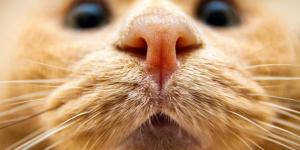My Cat Has a White Nose - Causes and What to Do



See files for Cats
All cats do not have a uniform color of nose, similar to their fur and eyes. The important thing we need to consider if we notice the coloration of a cat's nose is whether it is natural. Similar to a cat's fur and eyes, if there is a change in tonality in an adult cat, then it is a sign something may have happened. Kittens will change eye color and markings as they develop. For the nose, it is more common to see lesions or discharge changing its appearance, but as you will see in this AnimalWised article, it is possible our cat may have a white nose.
If your cat has a white nose, we explain the reasons this is the case and what we might need to do about it. We also stress the importance of distinguishing when a cat's nose changes color.
Is it normal for my cat's nose to change color?
There is no "normal" color for the nose of cats because each individual can have a nose of varying shades. For example, we can find cats with a nose the color of:
- Pink
- Black
- Chocolate
- Gray
- Patchy
The color of a cat's nose is directly related to the color of their fur. Genetic inheritance from their parents or even a mutation cause the cat's nose to be a certain color. Although a newborn kitten may have a very pink nose which develops coloration as they grow, the nose won't change color in the same way their eyes might.
When a cat's nose does change color, it may be a fairly normal reaction. When a cat's temperature raises or they are stressed, their blood vessels will fill which can change the tone of the cat's nose. It will not, however, change the actual color.
If our cat's nose changes color to white, then it is likely the sign of a problem. We will need to look out for concurrent symptoms. For example, they may also be suffering weight loss, alopecia, fatigue, lack of appetite or even have injuries. Dipigmentation in the cat's nose can be related to a decrease in red blood cells, among others.
Why does my cat have a white nose?
The nose can give us clues about the state of health of a cat. Some people think that a cat having a dry nose indicates they have a fever, but this is a myth. The only way to determine if they have a fever is to take their temperature. If your cat has a dry nose and it has turned white, it may not be a fever, but it is still possibly a sign of a problem.
If your cat has a white nose it may be due to the possible causes:
- Dehydration
- Anemia
- Hypothermia
- Vitiligo
We explain these causes in the sections below:

1. Dehydration
When a cat does not have sufficient water intake, they will become dehydrated. This can be due to simply not consuming enough water. Cats can do this sometimes if it is hot and they forget to drink. However, it is not common for the cat to become so dehydrated their nose will turn white simply because they have forgotten to drink.
A cat is much more likely to become severely dehydrated if it is the symptom of an underlying disease. Not all of these diseases will result in their nose changing color, but some do, as you will see below.
2. Anemia
Anemia involves a decrease in the number of red blood cells. It may be because there are not enough being produced or they are being destroyed faster than they can be generated. This is partly why anemia is separated into regenerative or non-regenerative types:
- Regenerative anemia: this occurs where there is excessive bleeding or hemolysis, the latter being the breakdown of red blood cells. This occurs when the cat is suffering from certain diseases such as feline leukemia or mycoplasmosis. It may also be the side effect of taking certain medications.
- Non-regenerative anemia: this usually indicates a problem with either their bone marrow production, nutritional deficiencies, chronic inflammation, kidney disease or liver disease. This type of anemia has a worse prognosis.
Anemia in cats can be detected by a veterinarian via a blood test. However, it is possible we can see some symptoms which suggest they may have the problem. In very mild cases of anemia, it is likely asymptomatic. Physical examination which shows pale skin and mucus membranes suggests the cat may have developed anemia. The cat's gums may have turned white, but you can also see a change in color to their nose. Other symptoms may include weight loss, fatigue or appetite loss since the red blood cells are not transporting as much oxygen throughout the body.
Very serious anemia poses real danger to the life of the cat. They can become dehydrated when they stop eating and become hypothermic (i.e. a considerable drop in body temperature). This will require a visit to the veterinarian. In severe cases, the cat may need a blood transfusion. In milder cases, a change in diet and medication may be sufficient.
3. Hypothermia
As explained in the section above, a reduction in the cat's body temperature (hypothermia) is often the result of an underlying disease. However, it is also possible the temperature of a cat will be changed due to environmental factors. If a cat is stuck outside during very cold temperatures, for example, it is likely their nose will change color due to lack of blood circulation in the extremities. A white nose will be one of the least obvious signs your cat is suffering from hypothermia.
To prevent hypothermia in cats, check out our article on how to care for cats in winter.

4. Vitiligo
Vitiligo is a disorder with an unknown origin, although science suggests several hypotheses. Regardless of the cause, it may result in your cat's nose turning white. One theory suggests that antimelanocytic antibodies may appear. Melanin is a pigment that gives color to the skin, hair and the iris of the eyes. If it is destroyed, the result will therefore be the absence of color.
Depigmentation is what happens when a cat develops vitiligo, this usually affects the entire area of the nose. There are no other symptoms beyond the change in pigmentation, but we can see changes to the color of the cat's coat.
To confirm the diagnosis of this condition, it would be necessary to consult a pathological anatomy laboratory. However, it is unlikely a veterinarian will do this other than for research purposes. There is no treatment which can change the color back again. Fortunately, it does not seem more than an alteration to the cat's appearance and their well-being should not be affected. It appears to be more common in the Siamese cat breed.
Albinism in cats
There is another cause that explains why a cat has a white nose without implicating the presence of an underlying disease Albinism is considered a hereditary condition as it is passed on through genetics. Its result is the inability of the cat to develop pigment in their skin and fur. There is no treatment, but an albino cat can live a healthy life if the right precautions are taken.
We usually suspect albinism when the fur of the cat is completely white, one or both eyes is light blue, or if the skin on the cat's paw pads, lips and nose is pale pink. Albino cats are more likely to develop problems such as deafness, blindness and even skin cancer.
As the nose is not protected by the hair, a cat's nose will need to be given greater protection from the sun. However, albino cats will need particular attention due to the greater risk of feline skin cancers. Any cat can become sunburned which can result in a squamous cell carcinoma. This is characterized by lesions which are most prominent on the nose and ears.
Not all white cats, however, are albino. They are still likely to suffer from certain diseases, so we need to be observant for any adverse symptoms.

What to do if my cat has a white nose
As you have seen in the previous section, some of the causes that explain why a cat has a pale nose are serious health problems. This is why it is best to go to the vet as soon as possible. If you detect other symptoms such as those described, quick action can be key to obtaining a good prognosis.
To know more about your cat's general health, our video below explains the diseases most common to cats:

This article is purely informative. AnimalWised does not have the authority to prescribe any veterinary treatment or create a diagnosis. We invite you to take your pet to the veterinarian if they are suffering from any condition or pain.
If you want to read similar articles to My Cat Has a White Nose - Causes and What to Do, we recommend you visit our Other health problems category.
Bars, J. (2003). Veterinary Clinical Dermatology. University of Leon.
Sanz, N. (2017). The interpretation of the hemogram. Ateuves Magazine, 60, 20-23.








